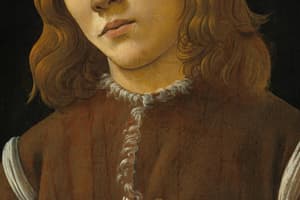Podcast
Questions and Answers
What is depicted in Sandro Botticelli's painting 'Primavera'?
What is depicted in Sandro Botticelli's painting 'Primavera'?
- Zephyrus abducting Chloris (correct)
- Venus in a sacred grove (correct)
- A winter scene
- A banquet with Roman gods
What does the standing pose of Venus in 'Birth of Venus' signify?
What does the standing pose of Venus in 'Birth of Venus' signify?
Divine beauty and sensuality
Domenico Ghirlandaio emphasized naturalism in his work 'Nativity and Adoration of the Shepherds'.
Domenico Ghirlandaio emphasized naturalism in his work 'Nativity and Adoration of the Shepherds'.
True (A)
What is the significance of Michelangelo's 'David' in Florence?
What is the significance of Michelangelo's 'David' in Florence?
What key component is reflected in Michelangelo's 'Creation of Adam'?
What key component is reflected in Michelangelo's 'Creation of Adam'?
Raphael's 'Madonna of the Goldfinch' portrays a childlike interaction between Mary and Christ, emphasizing ______.
Raphael's 'Madonna of the Goldfinch' portrays a childlike interaction between Mary and Christ, emphasizing ______.
What artistic technique is associated with Leonardo da Vinci's works?
What artistic technique is associated with Leonardo da Vinci's works?
Match the following terms with their descriptions:
Match the following terms with their descriptions:
The Medici family was the ruling family in ______.
The Medici family was the ruling family in ______.
The term 'High Renaissance' refers to artistic achievements characterized by realism and stability.
The term 'High Renaissance' refers to artistic achievements characterized by realism and stability.
What does Ovid's poem 'Fasti' signify in relation to Botticelli's 'Primavera'?
What does Ovid's poem 'Fasti' signify in relation to Botticelli's 'Primavera'?
Study Notes
Sandro Botticelli's Works
- Primavera: Depicts Venus in a sacred grove; trees create a halo effect. Blends natural and mythological elements, referencing ancient antiquity.
- Birth of Venus: Represents Venus's beauty without a Christian context; emphasizes sensuality and idealized nudity. Figures exhibit elongated anatomy and lack traditional perspective.
- The Calumny of Apelles: Features intertwined nude figures and an atmosphere perspective; reflects ancient Greek vase painting styles and focuses on thematic elements from antiquity.
Domenico Ghirlandaio
- Nativity and Adoration of the Shepherds: Highlights lifelike shepherds influenced by Flemish art and classical antiquity. Features a Latin inscription emphasizing Roman pagan culture's foundation for Christianity.
Michelangelo's Masterpieces
- David: A 17 ft. sculpture exemplifying classical contrapposto; symbolizes Florence's triumph over tyranny. Displays mastery of the human form with emotional expression and idealization.
- Ceiling of the Sistine Chapel: Critical to Catholicism, featuring sculptural-quality figures in a complex layout with themes of optimism and beauty.
- Creation of Adam: Highlights the power differential between God and Adam through nearly touching fingers; embodies Neoplatonism reflecting ideal forms on earth.
Raphael's Contributions
- Madonna of the Goldfinch: Symbolizes Christ's passion, featuring maternal tenderness and stability via triangular composition. Madonna represents divinity within nature.
- Small Cowper Madonna: Emphasizes the emotional connection and compositional balance in the portrayal of Mary and the Christ child.
Leonardo da Vinci's Innovations
- Mona Lisa: Features a mysterious landscape and engaging gaze, pioneering 3D spatiality and evoking humanism. Characterized by smoky lines enhancing realism.
- The Last Supper: Utilizes dynamic figures to convey betrayal and communion, employing linear and atmospheric perspectives for depth.
Art Techniques and Art Philosophies
- Classicism: Integrates references to ancient antiquity across works.
- Perspective: Key technique in Renaissance art to create spatial depth.
- Sfumato: Distinctive smoky quality present in Leonardo's paintings.
- Idealization: Enhances forms beyond their natural appearance for perfection.
- Neoplatonism: Philosophical approach emphasizing the manifestation of ideal forms in reality.
Historical Context
- Medici Family: Major patrons of the arts in Florence; Botticelli's Primavera served as a wedding gift for a family member.
- Influence of Mythology: References Greek gods such as Venus, Cupid, and Zephyrus in Botticelli's creations.
- Giorgio Vasari: Art critic who categorized the Renaissance into three stages, highlighting the progression of rule and proportion in art.
Other Notable Works
- Ovid, Fasti: Poem detailing the myth of Zephyrus and Chloris, central to Botticelli's Primavera narrative.
- High Renaissance: Marked by an artistic pinnacle focused on realistic figures imbued with spirituality, stability, and a natural setting.
Additional Terminology
- Refectory: Long table; often associated with communal dining in historic settings.
Studying That Suits You
Use AI to generate personalized quizzes and flashcards to suit your learning preferences.
Description
Explore key concepts and artworks from Chapter 4 focusing on Classicism and the High Renaissance. This quiz covers significant figures like Sandro Botticelli and themes related to mythological representations. Perfect for students wanting to deepen their understanding of art history during this pivotal era.



